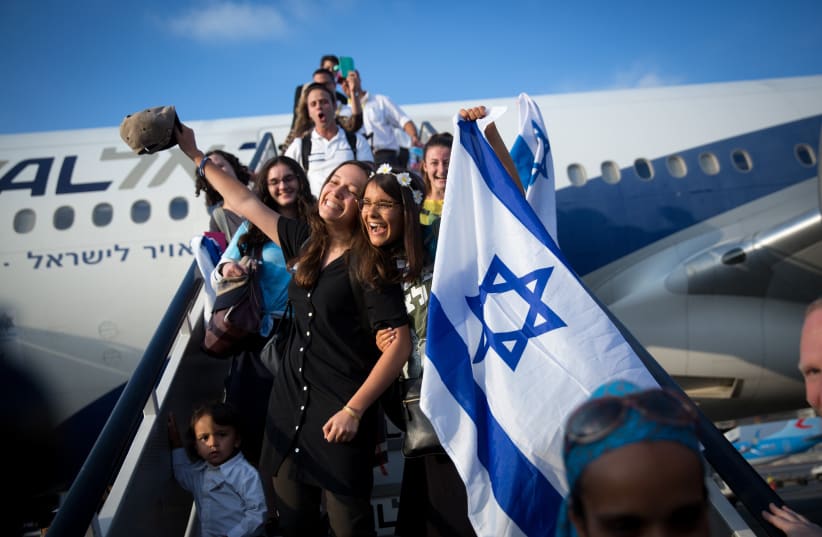Will an amendment of the Law of Return and the cancellation of the Grandson Clause actually cause a rift between American and Israeli Jews? According to new data, obtained and analyzed by Dr. Netanel Fisher, head of the Department of Public Policy at the Academic Center for Law and Science, barely any Americans made aliyah using the Grandson Clause.
Over the past decade, only 67 grandchildren of Jews immigrated to Israel from the US, he told The Jerusalem Post on Tuesday. These grandchildren, who are not Jews themselves, immigrated to Israel by virtue of the Grandson Clause in the Law of Return.
According to Fisher, an expert on immigration and conversion, this number of olim is less than 1% of all immigrants during that period (about 21,000 olim from the US). Therefore, 99% of US olim are Jewish or first-degree relatives of Jews. By comparison, about 70% of olim from the former Soviet Union countries are not regarded as Jews.
The data refer to the years 2010-2021 and are based on a study of immigration to Israel that was conducted by Fisher. The study used Jewish Agency data and refers to olim who immigrated from the US. The study does not include immigrants who changed their status and became olim during their stay in Israel, such as men who were studying in a yeshiva and decided to make aliyah while living in Israel.
According to Central Bureau of Statistics data, since the establishment of the state, about 120,000 immigrants have come to Israel from the US. In recent years, there has been a slight increase in the number of annual immigrants, and it ranges from between 2,500 to 4,000 olim per year.
However, it turns out that there are almost no non-Jewish immigrants from the US. Of the approximately 25,000 immigrants who immigrated from the US in the last decade, including those who did so during their stay in Israel, only 5%, about 1,300 people, were not recognized as Jews.
This small amount of olim is not expected to be harmed by the proposed change in the Law of Return. The absolute majority, about 90% of the non-Jewish immigrants from the US, are close family members, such as spouses and children of Jews and therefore will be eligible for aliyah.
Those who would be affected by a change in the law are the non-Jewish immigrants from countries such as the former Soviet Union. Non-Jewish immigration from the US, according to the data, is very small and includes family members of the first degree, whose immigration is not discussed within the Grandson Clause amendment.
Large number of US Jewish converts make Aliyah, data shows
However, according to Fisher’s research, there is a fairly high percentage of converts immigrating to Israel from the US. about 1,500 converts immigrated over the past decade, an average of 120 per year. The immigrating converts make up an average of about 7% percent of all US immigrants.
Based on the data, it is not possible to know what streams of Judaism converted these Jews, Fisher said.
“There is a relatively high percentage of converts who make aliyah from the US,” he said. “This group of olim is larger than their percentage in the entire Jewish population in the US [of converts to Judaism]. Therefore, the assumption is that a huge percentage of converts make aliyah after they finish their conversion process in the US.”
The study shows that “the discussion about the Grandson Clause is not relevant at all to immigration from the US,” Fisher said. “Yet the surprising percentage of converts requires us to act sensitively on the issue of recognizing conversions carried out in the Diaspora.”
American Jewish leaders concerned for the future of Aliyah
The reasons that American Jewish organizations and leadership are worried about a change in the Law of Return has to do with two major issues: Many of the grandchildren of children of these leaders are not married to Jews or acknowledged as Jews, according to the Chief Rabbinate in Israel. If they would want to make aliyah in the future, they would not necessarily be able to do so.
In addition, the majority of American Jews are not Orthodox. About 10% of US Jews consider themselves to be Orthodox or haredi (ultra-Orthodox), and the vast majority are either unaffiliated, Reform or Conservative.
In this case, with a high rate of intermarriage and Reform rabbis officiating at mixed marriages, many American Jews will not be considered as Jews according to Halacha within a few decades. Also, liberal and progressive values are a major part of the identity of non-Orthodox American Jews, and they would consider such a decision as being dramatic and negative.

